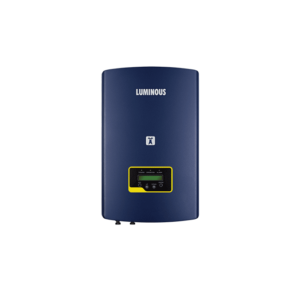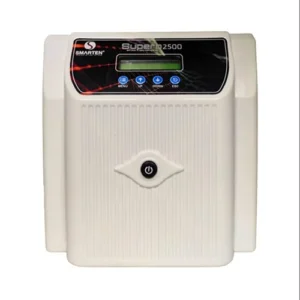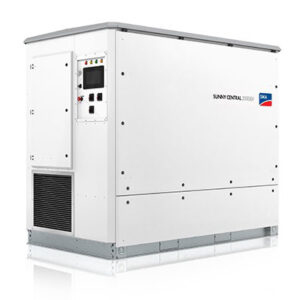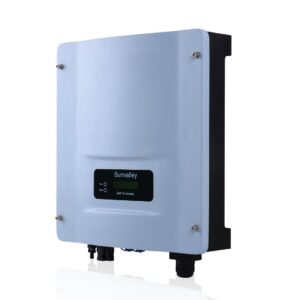On Grid Solar Inverter
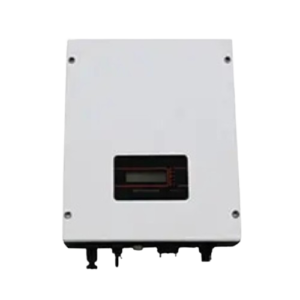
Photovoltaic cells in solar photovoltaic (PV) systems use solar radiation to generate direct current (DC) electricity. However, a device is required to convert DC to AC because the majority of power networks use alternating current (AC). This is where on-grid inverters come in. The main component of energy conversion and control for grid-connected photovoltaic systems is an on-grid tie inverter, which transforms the DC power output from the solar cells into AC power that satisfies the grid’s needs and then feeds it back into the grid.
Because of the unique properties of the on-grid inverter’s input energy, its output power exhibits discontinuous unpredictability throughout the day as temperature, solar intensity, and other variables change. The electricity grid has an intermittent effect, and there is no energy generation at night. One type of electronic device that can transform DC electricity into AC power is an on-grid inverter. Voltage control, inversion, and rectification are among its fundamental operations. The on-grid inverter may convert the DC power produced by the solar PV system into the AC power needed by the power network by carrying out these steps.
Principle of Operation:
- DC Input: The DC power generated from the solar PV cells enters the on grid inverter.
- Rectification: The DC is converted into an intermediate DC, usually using a rectifier bridge circuit.
- Inverter: Converts the intermediate DC to AC using the on grid inverter section.
- Voltage Adjustment: Adjusts the voltage, frequency, and other parameters of the output AC to meet the requirements of the power network.
- On-grid: connect the output power of the on grid inverter to the power network to realize synchronous operation with the power grid.
The way these inverters operate is by transforming the solar panels’ direct current (DC) electricity into alternating current (AC), which is the typical type of electricity utilized in residences and commercial buildings. Since the majority of appliances and the electrical system itself run on AC power, this conversion is essential.
MPPT (highest Power Point Tracking) algorithms are essential parts of these solar inverters. They optimize the power output of the solar panels by continuously modifying the operating point to get the highest amount of electricity possible from the panels in a variety of environmental circumstances.
On grid solar inverter also need to align their output with the phase and frequency of the AC power coming from the grid. This synchronization guarantees smooth grid integration, enabling the feeding of excess electricity produced by the solar panels. returned to the grid for future use.
In addition, safety features like anti-islanding prevention, which stops the system from continuing to energize the grid in the case of a power outage, are included into PV grid-connected inverters. This guards against system damage and safeguards utility employees.
In order to provide dependable and secure functioning within the larger electrical infrastructure, the on-grid tie inverter operation principle generally centers on the effective conversion of solar energy into useable AC electricity, synchronization with the grid, and adherence to safety regulations.
Application Areas of On grid solar inverter
Distributed Power Generation System: In a distributed power generation system, solar PV arrays are converted from DC to AC using on on-grid inverter, which is then connected to the power network. This application makes it possible for the solar system to provide power for local power equipment and inject excess power into the grid, realizing a two-way flow of energy.
Solar Power Plants: In large solar power plants, hundreds of solar PV modules are connected to the power network via on-on on-grid inverters. The efficient performance and reliability of the inverters are critical to the overall operation of the solar power plant.
Home PV Systems: More and more households are choosing to install solar power systems that generate their own electricity and supply excess power to the electricity network via on-on on-grid inverters. This not only reduces household energy costs but also helps to minimize reliance on conventional electricity.
Commercial and Industrial Applications: In the commercial and industrial sectors, solar power systems are often used to power businesses. With on on-grid inverters, these systems have the flexibility to convert solar energy into electricity that can be used for production and operations, enabling the sustainable use of energy.
Types of On Grid Solar Inverter :
There are three broad categories of solar inverters. These include –
String Inverter
These solar inverters are directly connected to the grid. They are the most widely used category of solar inverter for both domestic and commercial purposes. String inverters usually do not come with a battery backup. That being said, you do not need a battery in an on-grid solar system: the grid does the job.
Micro Inverter
The Micro inverters are relatively smaller in size but costlier than the string inverters. This category of inverters usually comes with a capacity range of 200-350 W.
Installed individually on the back of each solar panel, the micro-inverter are ideal for places where there is a disparity in the amount of sunlight received by an individual solar panel.
Central inverter
It used in photovoltaic solar system in which a number of solar panels are connected in series with each other providing a string, then one string or more will be connected to a single solar inverter called central inverter. The inverter will convert strings DC voltage to AC voltage which can be usable in our house to run our appliances/equipment or to be connected to the electricity grid forming grid tie solar system. Usually the number of solar panels in one string are between five and thirteen panels, it differs based on what will be required string overall power capacity and DC voltage. The central inverter may have one MPPT input of more, if it has one MPPT input, this means that it accepts one or more strings which are the same, we mean they must be equal in number of panels and output power capacity.
Key Features and Benefits:
- High Power Capacity. Central inverters are capable of handling large power outputs, making them suitable for large-scale solar installations like commercial solar farms or extensive residential systems.
- Proven Technology. Central inverters have been in use for many years and their technology is well-established and trusted. They have a track record of reliability and performance.



